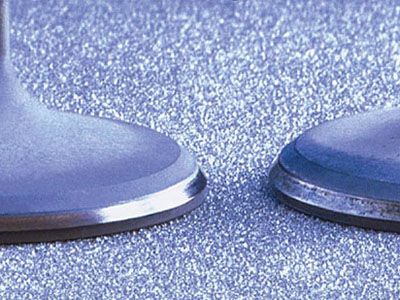
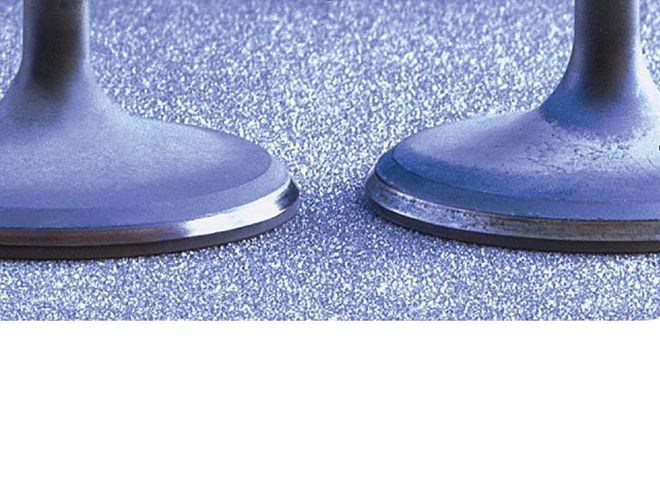
A side-by-side comparison of intake valves removed from a NASCAR Nextel Cup engine. The valve on the left is coated with Casidiam(r) while the other is uncoated. Each valve has gone through 1.5 million cycles.
Component life in a racing application has always been important. The idea of throwaway parts is not embraced by successful teams. If there's a way to get extended life, it has to be considered. If that extended life comes about without noticeable degradation of performance, that's even better. The valve application is one in which the customer's goal was to reduce performance degradation as well as extend part life. This team used to lose approximately 7 to 8 hp by the end of a race due to seal degradation between the valve and the head. Casidiam(r) reduced degradation to 1 to 2 hp.
Top-level racers have turned to the use of Casidiam(r), a diamond-like carbon thin film that can be applied on certain parts. While the technology may be new on this side of the pond, it has been around for five years, and European racers have been utilizing it for nearly 13 years. Through the efforts of Denver, North Carolina-based Anatech Ltd., teams are beginning to understand how some components withstood the rigorous requirements of formula racing.
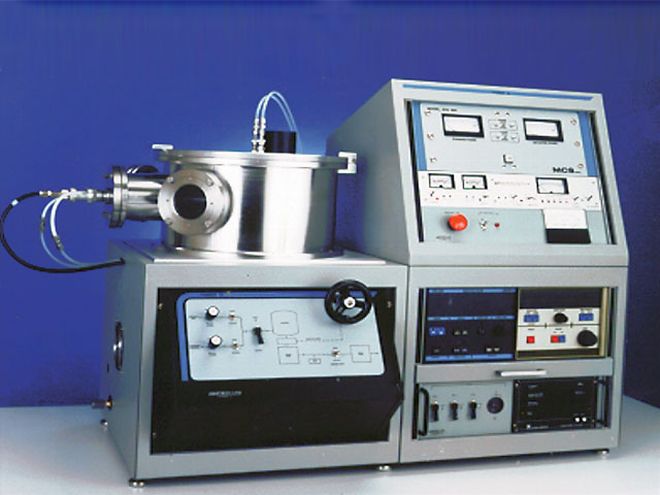 Parts are placed within the vacuum deposition system chambers for the processes to run their course.
Parts are placed within the vacuum deposition system chambers for the processes to run their course.
"We serve many of the top teams in NASCAR," says Anatech founder and President George Barr. "From there, we just keep drilling into the ranks of the circle track market." The technology can also be found in road racing and drag racing applications.
Wristpins for pistons became the starting point for racers to realize the benefits of the process. Now there are other areas where Casidiam(r) coating can play a key role in product performance.
"The biggest area seems to be in the engine," continues Barr. "We do work on steering system parts and shock shafts. It can be applied to steel, stainless steel, aluminum, and titanium. Casidiam(r) cannot be used on materials like zinc, tin, copper, and brass. These metals are not vacuum friendly."
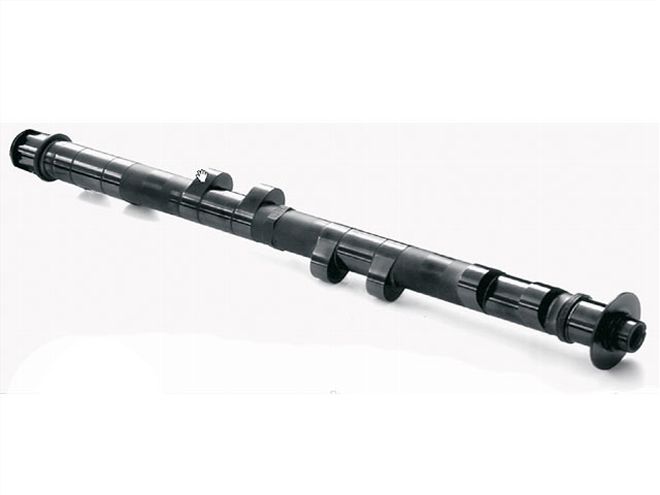 By the nature of its role in the engine, the camshaft is a key candidate for the efficiency of Casidiam(r). Engine friction can be reduced by 1 percent, and part life can be extended hundreds to thousands of miles.
By the nature of its role in the engine, the camshaft is a key candidate for the efficiency of Casidiam(r). Engine friction can be reduced by 1 percent, and part life can be extended hundreds to thousands of miles.
Creating the Coating Casidiam(r) uses the Plasma Assisted Chemical Vapor Deposition (PACVD) process, a derivation of the Physical Vapor Deposition (PVD) process that has been the cornerstone of Anatech since it was founded in 1981. In the PACVD process, a vacuum pump evacuates a chamber to proper pressure after the parts have been placed inside the chamber. A gas is introduced with the proper hydrocarbon composition as well as other components. A radio frequency is used to crack the gas into a plasma state. Plasma is a forced state of matter that will spread out and flow in a laminar fashion needed for this process. Since the chamber wall quenches the plasma, the parts cannot be placed too close to that wall. Plasma is the most prevalent state of matter in the universe. And, while its existence is forced in the chamber, it's pretty easy to create. It's harder to control. It's known as the fourth state of matter.
The plasma is an ionized gas with roughly an equal number of positively (ions) and negatively (electrons) charged particles and neutrals.
This process can be simplified by comparing it to a fluorescent light. You have two electrodes that crack the gas contained within the vacuum tube (light bulb) to create the light from the fixture.
The process will allow the hydrocarbon plasma to pass by the parts, and the carbon will condense onto the parts. Since the plasma temperature is higher than that of the parts being coated, it will condense one molecule at a time. The particles arrive at the same energy level with a 90-degree attitude to surface application. The plasma evolves to a solid on contact with the part. The ions can be attracted to the part surface with an electrical bias. Most of the bonding is done chemically, which is nine times stronger than a mechanical bond. The PACVD process is more conducive to chemical bonding than the PVD method.
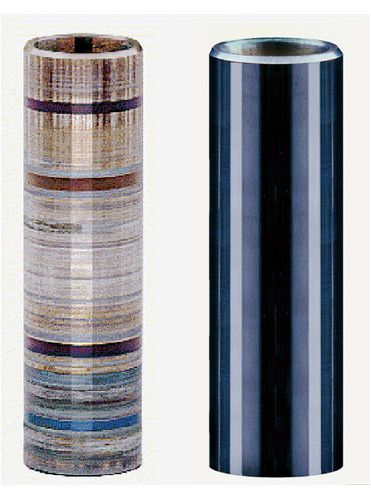 These wristpins show the obvious benefit of Casidiam(r). The Casidiam(r)-coated unit (right) shows reduced galling and can be expected to last longer. Formula One teams have used Casidiam(r) on racing parts for nearly 15 years.
These wristpins show the obvious benefit of Casidiam(r). The Casidiam(r)-coated unit (right) shows reduced galling and can be expected to last longer. Formula One teams have used Casidiam(r) on racing parts for nearly 15 years.
The process is known as a "green" process. Nothing toxic is emitted from the chambers, with only water vapor and carbon dioxide expelled.
Advantages Casidiam(r) changes the surface properties of the metals to allow greater wear, eliminate galling, and extend the life. This is accomplished through high hardness and low friction. The lubrication properties are evident in self-lubricating areas such as wristpins. "Casidiam(r) wears as a graphite, so it's self-lubricating," explains Barr.
The application amount is minute. Casidiam(r) is produced in 2 to 4 microns, which is equivalent to 80- to 160-millionths of an inch, depending upon the application. With such a small amount of material, the dimensional changes of the parts are nonexistent.
Another advantage is the uniform thickness over three-dimensional components. Casidiam(r) will coat over sharp edges such as 90-degree breaks. It will withstand high contact stress with no delamination. It'll withstand high Hertzian levels, broad scuffing, and fretting stress, not high-point load stress. That is, it's highly elastic, not highly plastic.
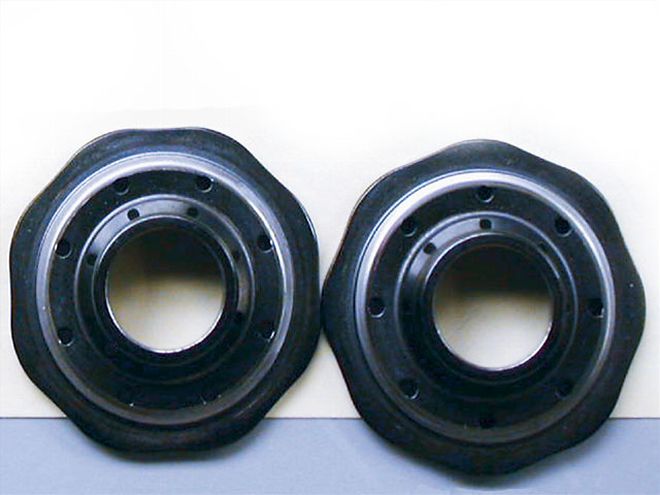 The Casidiam(r) coating on these spring retainers is inspected after a 400-mile NASCAR Nextel race. The Casidiam(r) is intact on the spring loading surfaces. Some coating breakthrough and wear occurred on the damper contact surface.
The Casidiam(r) coating on these spring retainers is inspected after a 400-mile NASCAR Nextel race. The Casidiam(r) is intact on the spring loading surfaces. Some coating breakthrough and wear occurred on the damper contact surface.
Further advantages include no changes to the metallurgical properties of the substrate material, maintaining the finish even on polished surfaces.
With respect to friction, increased testing has shown the coefficient of friction to be favorable. The coefficient of friction was lowered 45 percent on steel. The difference was greater with titanium as results showed a 75 percent reduction.
Casidiam(r) can be used as a replacement for Teflon(r). Since Teflon(r) is actually a liquid (much like glass is a liquid), it will move and create areas of coarseness, which would not occur with Casidiam(r). It can pick up impurities that embed into Teflon(r) and turn it into a scrubber.
Casidiam(r) is highly flexible. It has been tested on aluminum foil and held its ground when the foil was flexed and crumpled repeatedly.
Uses of Casidiam(r) Moving parts stand to gain the greatest benefit by virtue of the superior performance in the area of friction. "The best performance occurs when the substrate is as hard as possible," adds Barr. "It sticks and performs better on a surface with a better finish. Parts manufacturers need to have the best finish. This is why these parts can withstand the 8,000- to 10,000-rpm demands that they can see. It starts with quality materials, quality finish, and then concludes with Casidiam(r).
"We're not a parts manufacturer. We're not engine builders. In order for us to do this right, we need to plug into those worlds and work with those people. They know what's going on and what's needed, so we want to work closely with them both."
Some of the racing rules have sent parts makers and engine builders looking for this type of technology. "The one engine rule (in NASCAR) has prompted teams to look at the parts that they used to think were disposable," continues Barr. "Now they have to run those engines as much as 700 miles, and they need the parts to last."
On a production basis, parts that are going to be coated must be new and unused. The process will be less effective if the part has seen any use. Casidiam(r) can be applied if contaminants are removed through bead-blasting or a similar process. Residues from any heat-treating process must be removed from the surface. Also, oxidation (rust) can prevent Casidiam(r) from adhering to a substrate. Residuals from the polishing process also should be taken off. It is best to contact Anatech before considering Casidiam(r) over another coating.
Diamonds are Forever Casidiam(r) is actually a hard carbon. "There is no diamond in it," says Barr. "The properties are diamond-like, meaning it is very, very hard." There is the perception that diamonds are the hardest form of carbon, so this is how the hardness is best explained.
The hardness is another key component in withstanding wear. Laboratory measurements have found Casidiam(r) is approximately three times as hard as the applied metal. With that level of toughness, there is increased wear life due to the ability to withstand high contact stress.
The Future of Casidiam(r) Barr made a presentation at the 2004 Advanced Engine Technology Conference in Colorado Springs last January. The engine builders in attendance were receptive to the idea of getting better parts and performance.
"We have to keep looking for ways to work with them," Barr says. "When the limit is reached in one area, we need to explore other areas where the process will work well."
As such, Casidiam(r) is not a fad or a snake oil solution. It is a process endorsed by winners, though it falls into the classification of toiling anonymously. After all, no professional team is going to let the cat out of the bag. The results speak for themselves. If there's an engine still running and running strong at the end of a race, you can expect there's Casidiam(r) nearby.